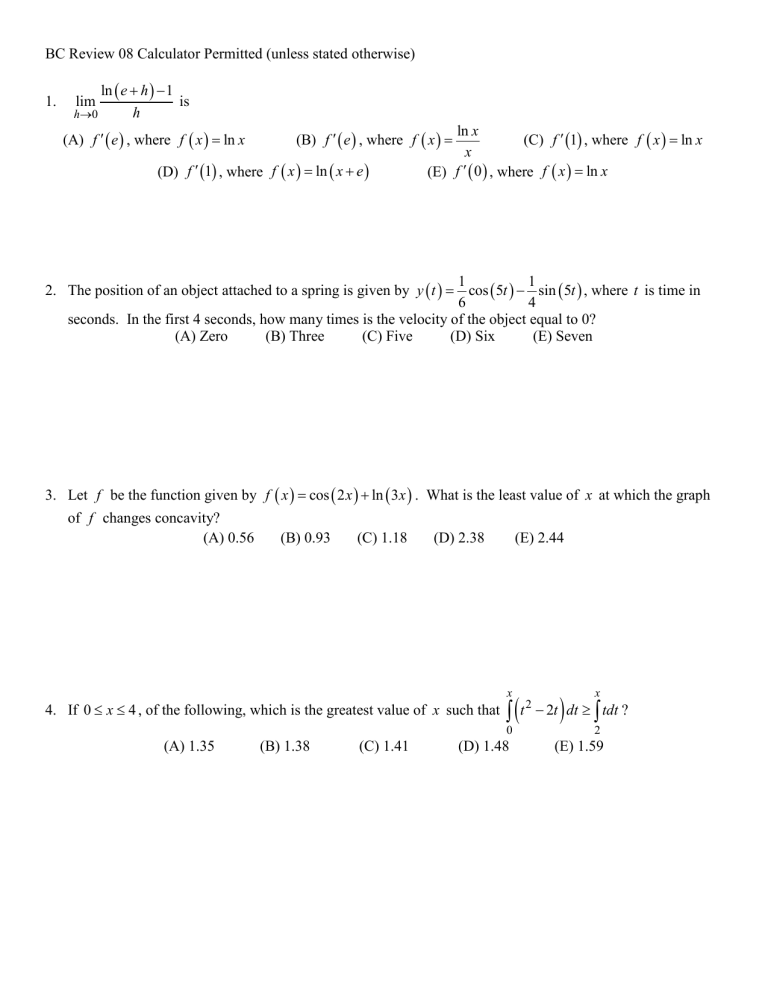
BC Review 08 Calculator Permitted (unless stated otherwise) 1. ln e h 1 is h h0 lim (A) f e , where f x ln x ln x (C) f 1 , where f x ln x x (E) f 0 , where f x ln x (B) f e , where f x (D) f 1 , where f x ln x e 1 1 2. The position of an object attached to a spring is given by y t cos 5t sin 5t , where t is time in 6 4 seconds. In the first 4 seconds, how many times is the velocity of the object equal to 0? (A) Zero (B) Three (C) Five (D) Six (E) Seven 3. Let f be the function given by f x cos 2 x ln 3x . What is the least value of x at which the graph of f changes concavity? (A) 0.56 (B) 0.93 (C) 1.18 (D) 2.38 4. If 0 x 4 , of the following, which is the greatest value of x such that (A) 1.35 (B) 1.38 (C) 1.41 (E) 2.44 x t 0 (D) 1.48 2 x 2t dt tdt ? 2 (E) 1.59 5. If dy y y ln x and if y 1 when x 1 , then y dx (A) x 2 1 x2 e (B) 1 ln x (C) ln x 2 x x ln x 2 (D) e (E) e x ln x 6. Let f be a continuous function on the closed interval 3, 6 . If f 3 1 and f 6 3 , then the Intermediate Value Theorem guarantees that (A) f 0 0 4 for at least one c between 3 and 6 9 (C) 1 f x 3 for all x between 3 and 6 (B) f c (D) f c 1 for at least one c between 3 and 6 (E) f c 0 for at least one c between 1 and 3 7. x 2 sin xdx (A) x 2 cos x 2 x sin x 2 cos x C (C) x 2 cos x 2 x sin x 2 cos x C (B) x 2 cos x 2 x sin x 2 cos x C (D) x3 cos x C 3 (E) 2 x cos x C 8. Let f be the function given by f x x 1 cos t 2 dt 1/3 does f attain a relative maximum? (A) 0.357 and 0.798 (B) 0.4 and 0.564 for 1 t 1 . At which of the following values of x 3 (C) 0.4 only (D) 0.461 (E) 0.999 9. Let f be the function defined by f x x ln x . What is the value of c for which the instantaneous rate of change of f at x c is the same as the average rate of change of f over 1, 4 ? (A) 0.456 (B) 1.244 (C) 2.164 (D) 2.342 (E) 2.452 10. The height, h , in meters, of an object at time t is given by h t 24t 24t 3/2 16t 2 . What is the height of the object at the instant when it reaches its maximum upward velocity? (A) 2.545 meters (B) 10.263 meters (C) 34.125 meters (D) 54.889 meters (E) 89.005 meters 11. (2011, BC-2B) The polar curve r is given by r 3 sin , where 0 2 . (a) Find the area in the second quadrant enclosed by the coordinate axes and the graph of r . , there is one point P on the polar curve r with x-coordinate 3 . Find the angle that 2 corresponds to point P . Find the y-coordinate of point P . Show the work that leads to your answers. (b) For (c) A particle is traveling along the polar curve r so that its position at time t is x t , y t and such that d dy 2 at the instant that , and interpret the meaning of your answer in the contest of 2 . Find dt dt 3 the problem. 12. (No Calculator) (20138, BC-5)


